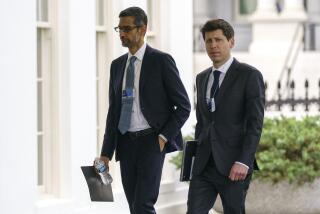Protecting the Shoulders We Stand On
- Share via
To the uninitiated, copyright law seems the domain of only high-priced lawyers and best-selling authors. Yet this wide-reaching law affects everyone who writes, publishes, sells, buys or even reads a protected work. Authors and publishers praise copyright for fostering creativity and encouraging publication, but it also limits the utility of protected works and constrains public access to information.
Copyright extends to art, motion pictures and computer software, but books and magazines remain at the center of legal and philosophical clashes. Last April, a group of publishers stirred these debates anew by suing Kinko’s Graphics Corp., alleging that book excerpts copied and sold to students at the request of university faculty violated copyright. The law expressly allows multiple photocopies for classroom use, although the amount of copying within this public privilege of “fair use” is amorphous at best.
Copyright grants exclusive rights of reproduction and distribution to authors, who often assign them to publishers. The rights are exclusive, but not comprehensive. Readers may still buy and sell books and check them out at libraries, and “fair use” allows the public to quote and copy protected works within “reasonable” limits. Authors’ rights and public rights are not found in nature; they are established by act of Congress.
After two decades of debates, hearings and reports, Congress passed the current copyright act in 1976. For the first time, fair use had changed from a judicial doctrine for dismissing small or socially beneficial infringements to a statutory provision. Authors and publishers feared that fair use would undermine their survival. Copyright, they argued, was their source of economic livelihood and the wellspring of creative energies. Educators, researchers and librarians, however, asserted that fair use was paramount to their success and growth. Reasonable amounts of materials must be photocopied and quoted, they contended, for effective teaching and research and for the advancement of knowledge.
Congress largely accepted the latter argument, reaffirming fair use for such purposes as teaching, research, criticism and news reporting. Yet the scope of permitted use remains unclear. All circumstances must be evaluated together, particularly the purpose of the use, the nature of the copyrighted work, the amount and substantiality of use and its effect on the potential market for or value of the original work. The law gives only these general factors; nowhere does it set exact limits. Fair use is instead an inherently flexible “rule of reason” to be determined by the circumstances of each case.
The key argument for fair use lies in the Constitution, which empowers Congress to “promote the progress of science and useful arts, by securing for limited times to authors and inventors the exclusive right to their respective writings and discoveries.” Exclusive rights may encourage authors, but limits on those rights promote further progress by the public. The words of Isaac Newton from 1675 may well apply to copyright: “If I have seen further (than others) it is by standing upon the shoulders of Giants.” Fair use allows us to stand on shoulders, although not for a free ride. Copying should not substitute for purchase.
Fair use is most important for education. The law favors nonprofit uses over commercial purposes, and educators “promote progress” in keeping with the Constitution. American campuses are also centers of extensive photocopying for research, study and classroom distributions--the basis of the Kinko’s suit. The distinction between fair use and “free ride” for academia engenders sophisticated and mysterious battles, usually among faculty, administrators, legal counsel and librarians. Rarely do clashes erupt into lawsuits with publishers.
The complexities of copyright for education have precluded clear rules and absolute limits. Publishers insist that all photocopying for teaching and research should adhere to one of two procedures: Either obtain permission from the copyright owner, or stay within prescribed fair use guidelines. But these seemingly simple alternative often fail.
The problem with the first alternative (obtain permission), teachers complain, is that requests for permission go unanswered or require high royalty fees. The Copyright Clearance Center, which does not acknowledge Fair Use, collects fees and instantly grants photocopying rights on behalf of thousands of publishers. Unfortunately, fees of a few dollars per copy compound for large classes of students. Another problem with the first alternative is that classroom needs must be met on short deadlines, leaving too little time for formalities. Some publishers respond to this objection by allowing copies of recent materials--such as a short article from today’s newspaper--while insisting on the formalities for less time-bound materials.
As for the second alternative (stay within Fair Use guidelines), many find it more problematic still. Developed jointly by representatives of authors, publishers and educators, the guidelines first appeared in a congressional report accompanying the 1976 Act. These standards interpret Fair Use to allow single copies of articles, book chapters and other short works for research or teaching. Multiple copies for classroom uses must meet elaborate and rigid rules and be confined to fewer than 2,500 words from an article, with privileges further dependent on the number of authors, the immediacy of the need, and the overall frequency of copying. Full compliance requires teachers to document every word, author and instance of duplication.
The guidelines have been attacked then and now as unrealistic for higher education, but they were virtually the sole explanation of Fair Use, and the congressional report gave them the imprimatur of law. The guidelines received an enormous boost in 1983 when New York University adopted them to settle a suit much like the current Kinko’s case. Publishers had sued NYU, several faculty members and a commercial copy shop for excess photocopying.
Through legal strategies and effective publicity, many academics now follow the Fair Use guidelines. Publishers’ efforts this year include the Kinko’s suit and a booklet titled, “Questions and Answers on Copyright for the Campus Community,” prepared jointly by the Assn. of American Publishers and the National Assn. of College Stores. The booklet reiterates the guidelines but declines to assure that they offer shelter from liability. For example, the guidelines allow single copies for personal use, but the booklet stipulates: “There is no automatic exception for making even one unauthorized personal copy of a copyrighted work.” The booklet ultimately seems to retreat from Fair Use, urging users to seek permissions instead. If the publishers do not firmly endorse Fair Use under some set of guidelines, who else will?
Copyright owners have legitimate and serious concerns in an era of cheap and convenient photocopies, but the public must protect its rights of Fair Use with equal vigilance. Congress established Fair Use as a flexible rule of reason; the guidelines convert the law into quantitative mandates. Congress allowed multiple copies for classroom distribution and left the amount of copying to overall circumstances; the guidelines displace those conditions with word counts and exact parameters.
The guidelines are not law. They were not enacted by Congress, and no court has read them into Fair Use. NYU follows the guidelines by a voluntary settlement not binding on anyone else. Yet, whether through convenience, apprehension, lack of alternatives or effective persuasion, many colleges and universities have adopted the quantitative standards as their official policy. Copyright standards do more than avoid liability. They directly affect teaching and research, and thus affect the growth of knowledge, the exchange of ideas, and the progress of creativity. Our campuses support these missions, but they often lose sight of copyright’s role in the equation. Everyone should respect protections. Everyone should also resist the erosion of Fair Use.
More to Read
Sign up for our Book Club newsletter
Get the latest news, events and more from the Los Angeles Times Book Club, and help us get L.A. reading and talking.
You may occasionally receive promotional content from the Los Angeles Times.










